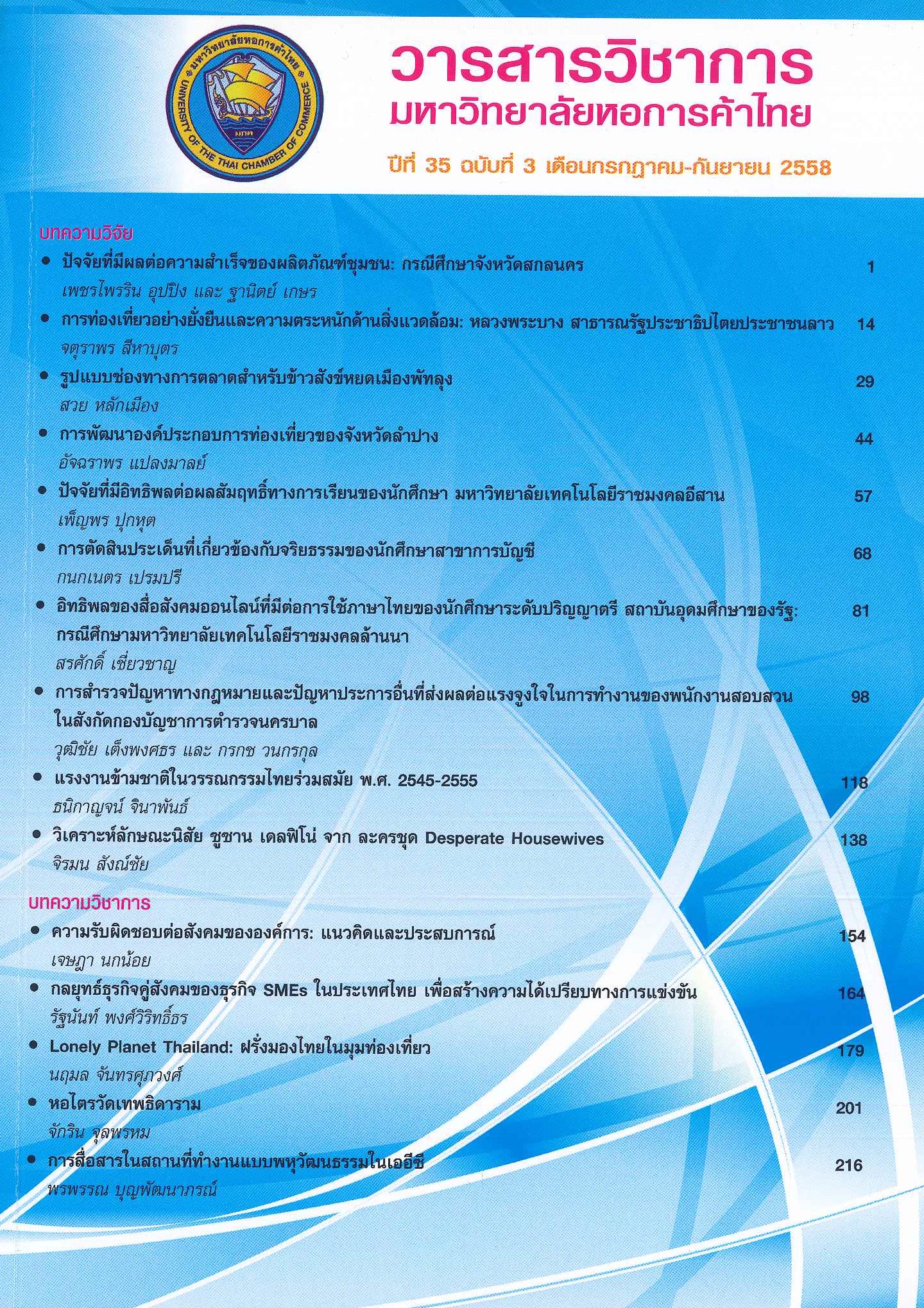Communication in AEC Multicultural Workplaces
Main Article Content
Abstract
AEC, Asean Economic Community, integration will be in effect by the end of 2015. There are possibilities of working with people from different cultures as there will be a free flow of a skilled workforce among member countries and from various parts of the world. Therefore, more offices will become multicultural workplaces. Apart from professional expertise, a capability to communicate appropriately with respect to others in intercultural settings is also very important because staff will have different beliefs, values, customs, and backgrounds which can easily lead to misunderstandings and confusion. This article seeks to present various cultural aspects that affect communication and, furthermore, gives some suggestions for adapting to new multicultural working scenarios including strategies for teachers to prepare students to approach the this new challenge.d working world.
Article Details

This work is licensed under a Creative Commons Attribution-NonCommercial-NoDerivatives 4.0 International License.
ลิขสิทธิ์ของบทความ
ผลงานที่ได้รับการตีพิมพ์ถือเป็นลิขสิทธิ์ของมหาวิทยาลัยหอการค้าไทย ห้ามมิให้นำเนื้อหา ทัศนะ หรือข้อคิดเห็นใด ๆ ของผลงานไปทำซ้ำ ดัดแปลง หรือเผยแพร่ ไม่ว่าทั้งหมดหรือบางส่วนโดยไม่ได้รับอนุญาตเป็นลายลักษณ์อักษรจากมหาวิทยาลัยหอการค้าไทยก่อน
References
Abolghasem, S.H.F. 2010. "Culture Assisted Language Learning (CALL) and Teaching General English." In EABR & ETLC
Conference, pp. 371-376. Ireland: Dublin.
Beamer, L., and Varner, I. 2001. Intercultural Communication in the Global Workplace. 2nd ed. Singapore: McGraw-Hill.
Bhasin, B. 24 April 2012. Asean's Diversity: Asset or Liability? [Online]. Available: www.bangkokpost.com/news/local/
290123/asean-diversity-asset-or-liability
Boonpattanaporn, P. 2014. "Opportunities for Practicing English: It is a Matter of Picking Them up." University of the Thai Chamber of Commerce Journal. 34, 3: 176-190.
Byram, M. 1997. Teaching and Assessing Intercultural Communication Competence. Clevedon: Multilingual Matters.
Byram, M., Gribkova, B., and Starkey, H. 2002. Developing the Intercultural Dimension in Language Teaching: A Practical Introduction for Teachers. Strasbourg: Council of Europe.
Collinsdictionary. 2014. Available: www.collinsdictionary.com/dictionary/American-cobuild-learners/cultural-awareness
Deardorff, D.K. 2006. "Identification and Assessment of Intercultural Competence as a Student Outcome of Internationali-zation." Journal of Studies in International Education. 10, 3: 241-266.
Education First. 2011. EF EPI Enalish Proficiency Index [Online]. Available: https://www.ef.co.th/sitecore/_//media/efcom/epi/pdf/EF-Epi-2011.pdf
Government of Canada. 2014. Canada's International Gateway [Online]. Available: https://www.canadainternational.gc.ca/ci-ci/index.aspx?lang=eng
Gunawan, M.H. 2014. Non-Verbal Communication: The Silent Cross-Cultural Contact with Indonesians [Online] Available: www.ialf.edu/kipbipa/papers/MuhamudHandiGunawan.doc
Hall, B.J. 2005. Among Culture: The Challenge of Communication. Belmont: Thomson Wadsworth.
Hall, E.T. 1976. Beyond Culture. Garden City: Doubleday.
Harper, A.M. 1997. "Cultural Adaptation and Intercultural Communication: Some Barriers and Bridges." In the Annual
Convention of the western Speech Communication Association, pp. 13. Monterey, CA.
Khan-Panni, P., and Swallow, D. 2003. Communicating Across Culture. Oxford: Howtobooks.
Kurylo, A. 2013. Intercultural Communication. Thousand Oaks: SAGE Publication.
Kwintessential. 2014. Global Etiquette [Online]. Available: www.kwintessential.co.uk/resources/global-Etiquette.html.
Liu, S., Volcic, Z., and Gallois, C. 2011. Introducing Intercultural Communication: Global Cultures AndContexts. London:
SAGE Publications.
Lustig, M.W., and Koester, J. 2013. Intercultural Competence: Interpersonal Communication Across Cultures. 7th ed.
ASA: Pearson Education.
The Nations Online Project. 2014. One world-Nations Online [Online]. Available: www.nationsonline.org
Neuliep, J.W. 2012. Intercultural Communication: A Contextual Approach. London: SAGE Publication.
Office of the Higher Education Commission. 2010. "Preparation for the ASEAN Community in 2015." Thai Higher
Education Review. 10, 33: 1-2.
Oliver, R.T. 1971. Communication and Culture in Ancient India and China. Syracuse: Syracuse University Press.
Patel, F., Li, M., and Sooknanan, P. 2011. Intercultural Communication: Building a Global Community. London: SAGE
Publication.
Ruben, B.D., and Kealey, D.J. 1979. "Behavioral Assessment of Communication Competency and the Prediction of Cross-Cultural Adaptation." International Journal of intercultural Relations. 3, 1: 15-47.
Samovar, L.A., Porter, R.E. and McDaniel, E.R. 2007. Communication Between Cultures. 6th ed. Belmont: Thomson
Wadsworth.
Sen, L. 2006. Communication Skills. New Delhi: Prentice-Hall.
Sorrells, K. 2013. Intercultural Communication: Globalization and Social Justice. Thousand Oaks: SAGE Publication.
Steinberg, S. 2006. Introduction to Communication. Cape Town: Juta.
Suthaceva, S., and Yuangsri, N. 2013. "Communication Problem Between Non-Thai and Thai Cabin Crew." In The 2nd
LITU International Graduate Conference Proceedings: Vol. 2, pp. 1042-1052. Bangkok: Thammasat University Press.
Tuleja, E. A. 2009. Intercultural Communication for Business. Canada: Nelson Education.
Vandenabeele, B. 2002. "The Need for Essences: On Non-Verbal Communication in First Intercultural Encounters." South African Journal of Philosophy. 21, 2: 85-96.
Wang, J. 2011. Communication and Cultural Competence: The Acquisition of Cultural Knowledge and Behavior
[Online]. Available: https://scholarworks.grsu.edu/orpc/vol7/iss1/3


